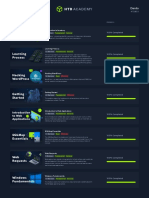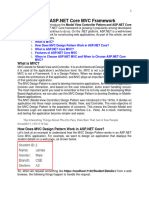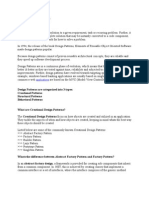MVC
MVC
Uploaded by
Amit GuptaCopyright:
Available Formats
MVC
MVC
Uploaded by
Amit GuptaCopyright
Available Formats
Share this document
Did you find this document useful?
Is this content inappropriate?
Copyright:
Available Formats
MVC
MVC
Uploaded by
Amit GuptaCopyright:
Available Formats
The Model-View-Controller (MVC) architectural pattern separates an application into three main
components: the model, the view, and the controller. The ASP.NET MVC framework provides an
alternative to the ASP.NET Web Forms pattern for creating Web applications. The ASP.NET MVC
framework is a lightweight, highly testable presentation framework that (as with Web Forms-based
applications) is integrated with existing ASP.NET features, such as master pages and membership-based
authentication.
1) The MVC framework is defined in the System.Web.Mvc assembly.
The MVC framework includes the following components:
Models. Model objects are the parts of the application that implement the logic for the
application's data domain. Often, model objects retrieve and store model state in a
database. For example, a Product object might retrieve information from a database,
operate on it, and then write updated information back to a Products table in a SQL
Server database.
In small applications, the model is often a conceptual separation instead of a physical
one. For example, if the application only reads a dataset and sends it to the view, the
application does not have a physical model layer and associated classes. In that case, the
dataset takes on the role of a model object.
Views. Views are the components that display the application's user interface (UI).
Typically, this UI is created from the model data. An example would be an edit view of a
Products table that displays text boxes, drop-down lists, and check boxes based on the
current state of a Product object.
Controllers. Controllers are the components that handle user interaction, work with the
model, and ultimately select a view to render that displays UI. In an MVC application,
the view only displays information; the controller handles and responds to user input and
interaction. For example, the controller handles query-string values, and passes these
values to the model, which in turn might use these values to query the database.
The MVC pattern helps you create applications that separate the different aspects of the
application (input logic, business logic, and UI logic), while providing a loose coupling between
these elements. The pattern specifies where each kind of logic should be located in the
application. The UI logic belongs in the view. Input logic belongs in the controller. Business
logic belongs in the model. This separation helps you manage complexity when you build an
application, because it enables you to focus on one aspect of the implementation at a time. For
example, you can focus on the view without depending on the business logic.
The loose coupling between the three main components of an MVC application also promotes
parallel development. For example, one developer can work on the view, a second developer can
work on the controller logic, and a third developer can focus on the business logic in the model.
You might also like
- AZ - 104 Test 5Document265 pagesAZ - 104 Test 5carlos davidNo ratings yet
- Student Transcript Danilo: Introduction To AcademyDocument5 pagesStudent Transcript Danilo: Introduction To Academynetto skyNo ratings yet
- Don't Panic!: CSC 105 A01 Midterm 2Document15 pagesDon't Panic!: CSC 105 A01 Midterm 2TerryNo ratings yet
- Exercises: Navigation BarDocument5 pagesExercises: Navigation BarRajat ChawlaNo ratings yet
- KSU Trumpet Syllabus 2017Document72 pagesKSU Trumpet Syllabus 2017Vini EbiNo ratings yet
- APA 6 - 6.1.1.2 Packet Tracer - Connect and Monitor IoT Devices PDFDocument9 pagesAPA 6 - 6.1.1.2 Packet Tracer - Connect and Monitor IoT Devices PDFLindoNo ratings yet
- Figure 01: Invoking A Controller Action That Expects A Parameter Value (Document7 pagesFigure 01: Invoking A Controller Action That Expects A Parameter Value (k102No ratings yet
- Model-View-Controller (MVC) : Architectural Pattern Software Engineering Business Logic User InterfaceDocument3 pagesModel-View-Controller (MVC) : Architectural Pattern Software Engineering Business Logic User InterfaceEk RahNo ratings yet
- MVC FrameworkDocument5 pagesMVC Frameworkganeshkhankal33No ratings yet
- System - Web.Mvc Namespace and Is A Fundamental, Supported Part of The System - WebDocument4 pagesSystem - Web.Mvc Namespace and Is A Fundamental, Supported Part of The System - WebzahidorakzaiNo ratings yet
- Niversity: Abdul Majid NiazaiDocument10 pagesNiversity: Abdul Majid NiazaiAbdulmajid NiazaiNo ratings yet
- Ecollege - College Management System - UploadDocument6 pagesEcollege - College Management System - UploadAfzal RahimNo ratings yet
- MVCDocument7 pagesMVChiwot kebedeNo ratings yet
- Model View Controller (MVC) : CSE-313 System Analysis & DesignDocument16 pagesModel View Controller (MVC) : CSE-313 System Analysis & DesignSakebul IslamNo ratings yet
- QuestionsDocument2 pagesQuestionsMannu BhiNo ratings yet
- What Is MVC?: ModelDocument3 pagesWhat Is MVC?: ModelGyan SinghNo ratings yet
- MVC Framework - IntroductionDocument2 pagesMVC Framework - IntroductionNajmaNo ratings yet
- MVC ConceptsDocument20 pagesMVC Conceptsdeepakdhembare28No ratings yet
- Module 4 (Chapter 2) PDFDocument5 pagesModule 4 (Chapter 2) PDFPillarisetty PremsaiNo ratings yet
- Model-View-Controller (MVC) Is A Software Architecture Pattern That Separates The Representation ofDocument1 pageModel-View-Controller (MVC) Is A Software Architecture Pattern That Separates The Representation ofAni RolonNo ratings yet
- MVCDocument21 pagesMVCMoeza ZayNo ratings yet
- System - Web Namespace.: Models. Model Objects Are The Parts of The Application That Implement The Logic For TheDocument12 pagesSystem - Web Namespace.: Models. Model Objects Are The Parts of The Application That Implement The Logic For TheagniswarNo ratings yet
- Model View ControllerDocument15 pagesModel View ControlleraparnajanwalkarNo ratings yet
- MVC PaperDocument12 pagesMVC PaperFranco CovarrubiasNo ratings yet
- LQ1. Explain Model, View and Controller in Brief: MVC ComponentsDocument3 pagesLQ1. Explain Model, View and Controller in Brief: MVC ComponentsShivaNo ratings yet
- MVC Interview QuestionsDocument89 pagesMVC Interview Questionsborhan uddinNo ratings yet
- MVC Sample IndtroductionDocument3 pagesMVC Sample Indtroductionrajeshb1392No ratings yet
- What Is MVCDocument8 pagesWhat Is MVCSyed hasan haiderNo ratings yet
- MVC Framework Introduction PDFDocument2 pagesMVC Framework Introduction PDFRAXNo ratings yet
- Introduction To MVC Pattern: Model-View-Controller (MVC) Is A Software Architecture or An Architectural PatternDocument8 pagesIntroduction To MVC Pattern: Model-View-Controller (MVC) Is A Software Architecture or An Architectural PatternmanishsatishNo ratings yet
- What Is MVC?: View Controller ModelDocument46 pagesWhat Is MVC?: View Controller ModelreshmaitagiNo ratings yet
- MVC by Own 1Document19 pagesMVC by Own 1Aravind BabuNo ratings yet
- Good?Document6 pagesGood?venkatbjNo ratings yet
- 07 Task Performance 1Document2 pages07 Task Performance 1Rose DadoNo ratings yet
- Austria - 07 Task Performance 1Document2 pagesAustria - 07 Task Performance 1mvaustria110204No ratings yet
- Microsoft Aspnet MVC CoreDocument69 pagesMicrosoft Aspnet MVC CorelookloNo ratings yet
- ASP Design PatternDocument302 pagesASP Design Patternvickydasuri111No ratings yet
- Introduction To ASP Full BookDocument497 pagesIntroduction To ASP Full Bookvickydasuri111No ratings yet
- Design and Functional SpecificationDocument25 pagesDesign and Functional SpecificationPreet ChhaoNo ratings yet
- Solid Principle, Architecture and Design PatternsDocument29 pagesSolid Principle, Architecture and Design PatternsYash BhardwajNo ratings yet
- Belajar Konsep MVCDocument1 pageBelajar Konsep MVCariyantorudyNo ratings yet
- An Introduction To Apache Struts Development With Oracle Jdeveloper 10GDocument13 pagesAn Introduction To Apache Struts Development With Oracle Jdeveloper 10GSuresh100% (2)
- Isolation Means: Onetariga: Develop Web Application That Enables A Clean Separation of CodeDocument20 pagesIsolation Means: Onetariga: Develop Web Application That Enables A Clean Separation of Codepravallika dasariNo ratings yet
- Learning MVCPart 1 Introduction To MVC Architecture and Separation of ConcernsDocument3 pagesLearning MVCPart 1 Introduction To MVC Architecture and Separation of ConcernsJoao PimentelNo ratings yet
- MVCDocument78 pagesMVCAsutosh MohapatraNo ratings yet
- TP HCI AGORDocument1 pageTP HCI AGORFOOD MASTERSNo ratings yet
- HCI - Chapter 7Document13 pagesHCI - Chapter 7John Michael JosolNo ratings yet
- Topic 3. Model-View-Controller ArchitectureDocument22 pagesTopic 3. Model-View-Controller ArchitectureccissnipesterNo ratings yet
- What Is MVC?: View Controller ModelDocument46 pagesWhat Is MVC?: View Controller ModelreshmaitagiNo ratings yet
- MVC Design PatternDocument4 pagesMVC Design PatternArafat ChowdhuryNo ratings yet
- MVC ArchitectureDocument5 pagesMVC ArchitectureUt PearlsNo ratings yet
- Mobile Aplication Development MVC ModelDocument13 pagesMobile Aplication Development MVC ModelAjit KushwahaNo ratings yet
- MVC Design PatternDocument1 pageMVC Design PatternNihal MohammedNo ratings yet
- MVC FrameworkDocument5 pagesMVC Frameworkagraharihardik9No ratings yet
- Unit VDocument109 pagesUnit V4074- RashmiNo ratings yet
- MVC 4 INTRODUCTION Lecture 01Document13 pagesMVC 4 INTRODUCTION Lecture 01rajpootNo ratings yet
- Lesson 21 - Develop Website Backend SystemDocument22 pagesLesson 21 - Develop Website Backend SystemDhoy NavarroNo ratings yet
- MVC4 Applications Presented by QuontraSolutions QuontraSolutionsDocument11 pagesMVC4 Applications Presented by QuontraSolutions QuontraSolutionsQuontraSolutionsNo ratings yet
- Design PatternDocument5 pagesDesign Patternrajaprabu_p7821No ratings yet
- What Is The Full Form of MVC?Document12 pagesWhat Is The Full Form of MVC?paparos486No ratings yet
- Web-Application Development Using The Modelniewlcontroller Design PatternDocument10 pagesWeb-Application Development Using The Modelniewlcontroller Design PatternOsorio WilgenNo ratings yet
- MVC Interview Questions PDFDocument9 pagesMVC Interview Questions PDFRAJINo ratings yet
- MVC Interview Questions: Click HereDocument20 pagesMVC Interview Questions: Click Heresuman prakashNo ratings yet
- Core MVCDocument135 pagesCore MVCR.A. AruneashNo ratings yet
- Difference Between MVC and MVT Design Patterns 1. Model View Controller (MVC)Document4 pagesDifference Between MVC and MVT Design Patterns 1. Model View Controller (MVC)Sarita SamalNo ratings yet
- Configuration Api For Kepserverex: Easy GuideDocument8 pagesConfiguration Api For Kepserverex: Easy GuideSau VoNo ratings yet
- L2CM Int12 - WaDocument7 pagesL2CM Int12 - WaDennis TanjusayNo ratings yet
- ACCS CustomReport ApplicationNoteDocument116 pagesACCS CustomReport ApplicationNoteFrancis NyanguwoNo ratings yet
- California Math Homework Book Grade 4Document8 pagesCalifornia Math Homework Book Grade 4dbrysbjlf100% (1)
- Uplers Web Development USDocument25 pagesUplers Web Development USMr AaryaNo ratings yet
- Week 1.B - Features and WebDocument39 pagesWeek 1.B - Features and WebHerynadel AdvinculaNo ratings yet
- 2023-RoboBoat Team-Handbook v1.0Document35 pages2023-RoboBoat Team-Handbook v1.0Ahmed MohamedNo ratings yet
- ProjectReport Website DevelopmentDocument29 pagesProjectReport Website DevelopmentNikunj Mani GuptaNo ratings yet
- It Workshop Lab ManualDocument85 pagesIt Workshop Lab Manualbalajiyadav0456No ratings yet
- Class Notes: Submitting A Class NoteDocument3 pagesClass Notes: Submitting A Class Notemochacino68No ratings yet
- Branded Entertainment ThesisDocument5 pagesBranded Entertainment Thesisamynelsonannarbor100% (2)
- Modern Technology in Language Linguistics and Social Sciences FinalDocument115 pagesModern Technology in Language Linguistics and Social Sciences FinalUganeswary MuthuNo ratings yet
- Kolej Profesional Mara Indera MahkotaDocument41 pagesKolej Profesional Mara Indera MahkotaWan Ahmad Qayyim Wan YazmanNo ratings yet
- MX410, MX417, MX510, MX511, MX517: User's GuideDocument321 pagesMX410, MX417, MX510, MX511, MX517: User's GuideOscarNo ratings yet
- GEHealthcare Education Catalog - X RayDocument50 pagesGEHealthcare Education Catalog - X RayEduardo Saul MendozaNo ratings yet
- HW6 DescriptionDocument15 pagesHW6 DescriptionPrabhatMishraNo ratings yet
- Summary of ESAS QuestionsDocument16 pagesSummary of ESAS QuestionsDan Edison RamosNo ratings yet
- Seminar ReportDocument34 pagesSeminar ReportAnchit AggarwalNo ratings yet
- Devfest London 2022 Schedule - GDG LondonDocument9 pagesDevfest London 2022 Schedule - GDG Londontibi geanuNo ratings yet
- Intro To Digital Technology Syllabus-Bdaughtery 1Document2 pagesIntro To Digital Technology Syllabus-Bdaughtery 1api-377548294100% (1)
- BUKPPODocument11 pagesBUKPPOjames espinosaNo ratings yet
- FactoryTalk LinxDocument121 pagesFactoryTalk LinxticojfsNo ratings yet
- iPhoneManual PDFDocument16 pagesiPhoneManual PDFSantosh KhadkaNo ratings yet
























































































